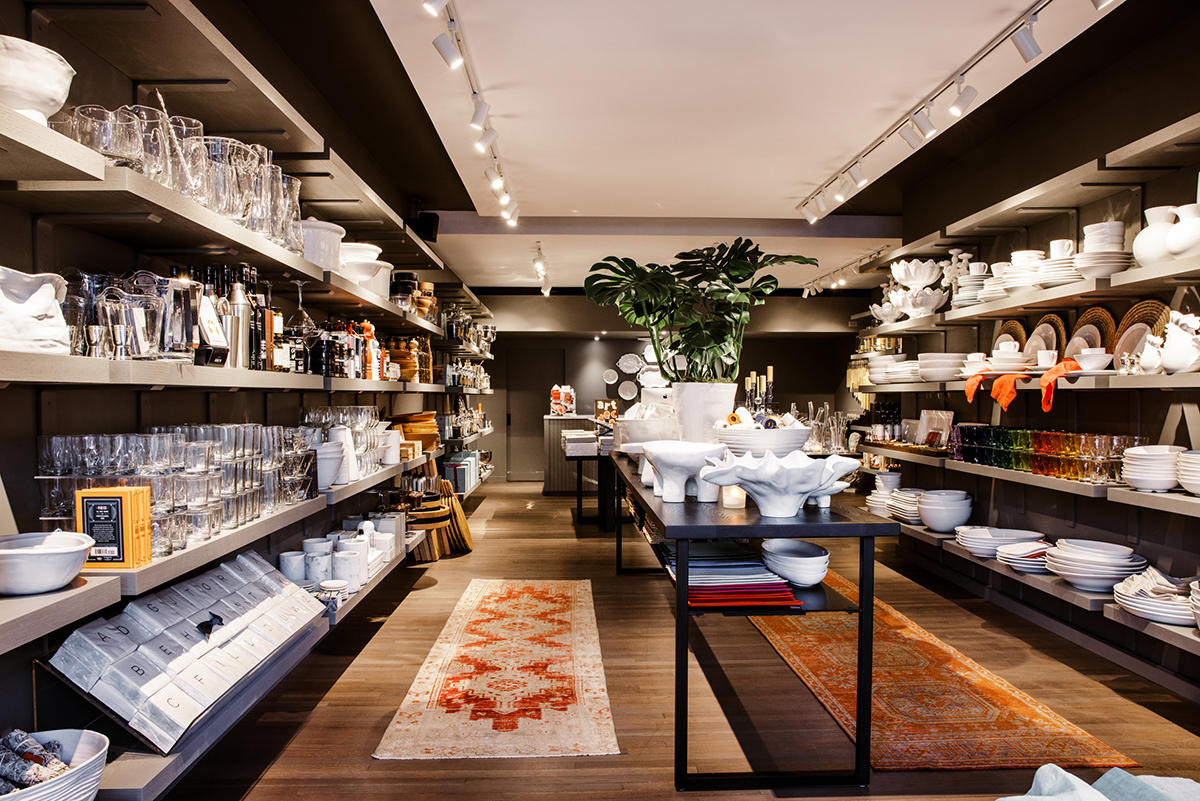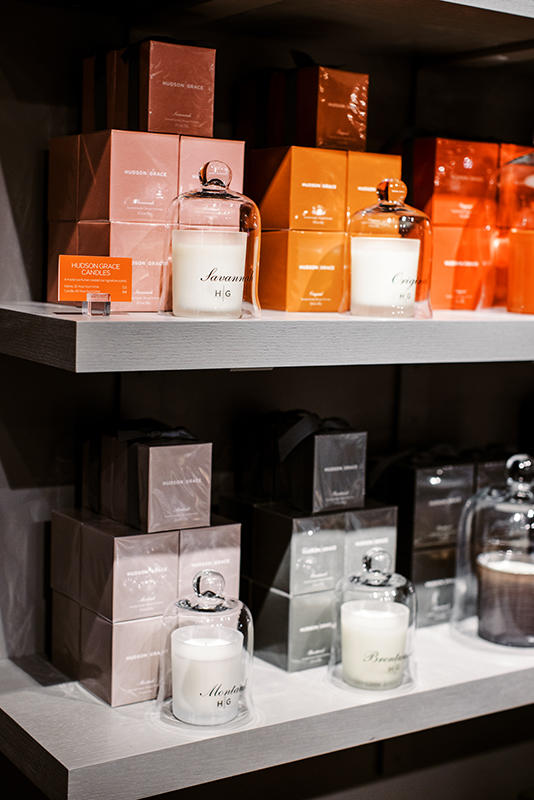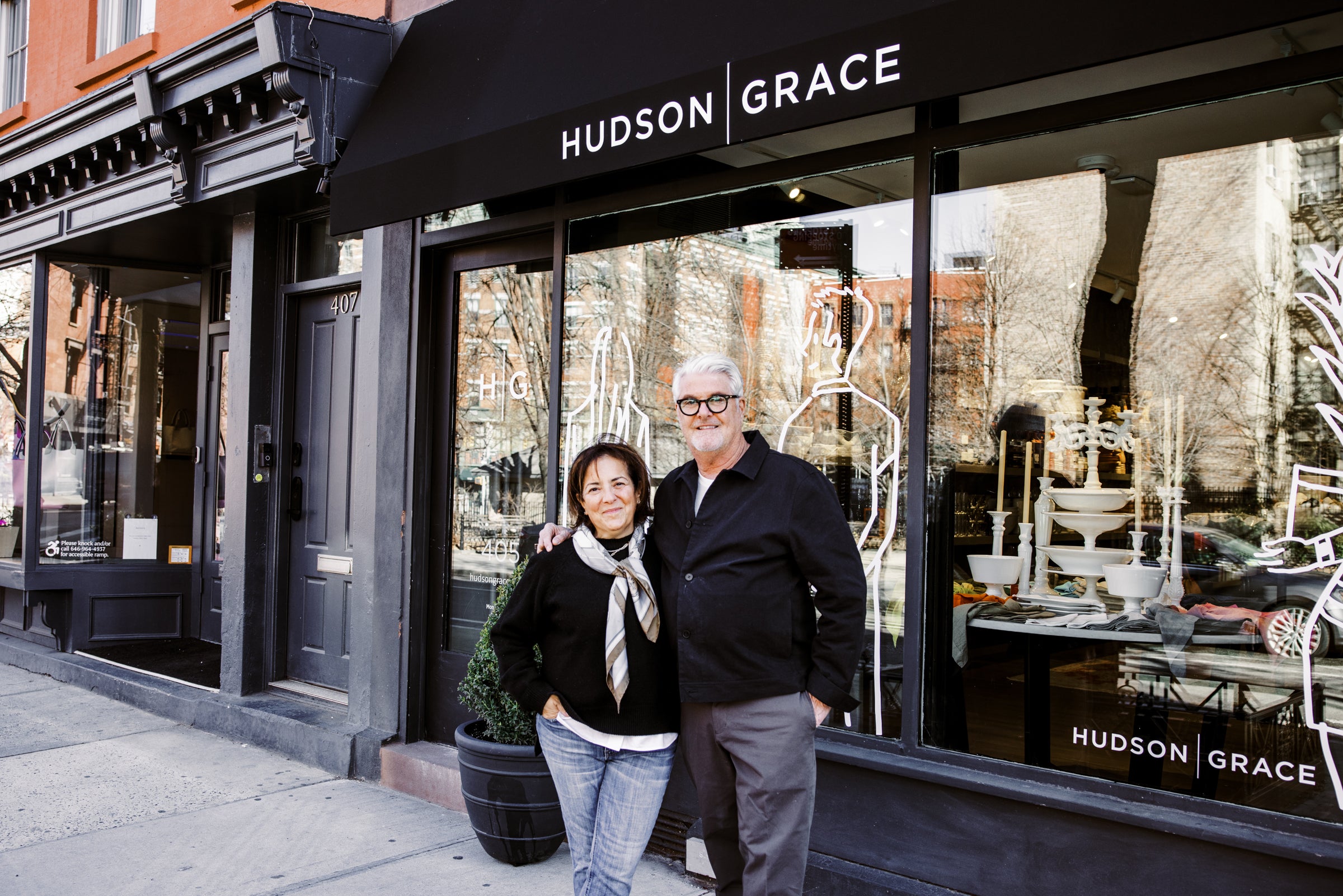In Business of Home’s series Shop Talk, we chat with owners of home furnishings stores across the country to hear about their hard-won lessons and challenges, big and small—to find out what they see for the future of industry businesses like theirs.
This week, we spoke with Monelle Totah and Gary McNatton, founders of the home goods brand Hudson Grace. The pair opened their first store in the Presidio Heights neighborhood of San Francisco in 2012 following long, overlapping careers developing product for companies like Williams-Sonoma and Gap Inc., and have since expanded to nine locations across the U.S. (the company was acquired by Crate & Barrel in 2019). Here, they explain how they’ve scaled while holding tightly to their vision, why they’ll always keep a candle burning and the unending importance of branding.

What were your backgrounds before the shop?
Totah: I started at Williams-Sonoma 20 years ago and had a wonderful career there, doing everything from merchandising to product design. I met Gary as a vendor of mine, and we got to be good friends. He called me to come work with him at Banana Republic and start Banana Republic Home, and we [worked at] the Gap for five or six years together. When they moved to New York, I went back to Williams-Sonoma and started Williams-Sonoma Home. My last leg there was as head of design for tabletop.
McNatton: I started a small brand in Los Angeles in the mid 1980s called Mottura. I designed some of the product, but mostly I was working with artists and artisans to develop product for me. I always felt that if a product was good, it had an energy, it had an aura. I was always seeking out those products that had that vibration. I connected with Molton Brown London, the fragrance brand, and got the distribution rights to bring it into the country. I also connected with a perfumer and florist out in East Hampton, New York, who had a perfume called Antonia’s Flowers. I fell madly in love with this fragrance, and it became the scent of my brand. I always believed that fragrance had a secret power to pull you in—to capture you, to take you someplace. A friend of mine said, “Why don’t you develop your own fragrance?” I said, “I don’t know much about it. The only fragrance I really know and love is the scent of fresh-cut grass.” About nine months later, I launched a line of little square glycerin soaps through Mottura. One was called Grass, one was called Heaven and one was called Dream. [They] won every design award there was to win. I got a call from Mickey Drexler’s office, and I went in and basically I sold my company to Gap Inc.
Then Mo and I worked on Banana Home. The president of Banana wanted us to move to New York, but we both had our homes, our lives and our families in California. That’s when we vowed one day we would do our own business. Mo went back to Williams Sonoma and I continued for a few more years at Gap Inc. Then Mo called me one day and said, “I think it’s time. We need to do our store.”

What was the vision for the store at the beginning?
Totah: We knew we wanted to be edited and focused. That’s something Gary and I both learned throughout our careers in retail—you can’t be everything to everybody. I definitely learned that through [Williams-Sonoma founder] Chuck Williams. We knew we wanted to have a curated assortment of the most wonderful tabletop entertaining pieces for the home.
McNatton: We both love having guests and entertaining. It’s a passion—
Totah: A huge passion, to cook and entertain. We also knew we needed to be exclusive and to build a brand. We curate vendors we love and adore. Our first glass, we called it our everyday wineglass. It’s the most wonderful glass, and Gary and I both owned it, and when we started building our product boards, we were like, “We have to have that glass.”
McNatton: We opened with branded merchandise, which was unusual. A guy came into our store on the first or second day, bouncing around, turning over things and asking a million questions, and he said, “How many stores do you have?” I said, “We just have one. We just opened yesterday.” He said, “You just opened yesterday? You’re branded.” I said, “Well, we don’t know how not to be branded.” That’s where we came from, and that’s all we know—you brand. We named the company Hudson Grace, inspired by two of our very close family members, Hudson and Gracie. It felt prestige. It felt comfortable. It felt real.
Was the store a smash right away?
McNatton: Well, yes, it was. We opened on Halloween Eve, because Presidio Heights has a big trick-or-treat event. We had candy and this enormous pumpkin in the window, and the door opened and they poured in.
Totah: They didn’t necessarily shop, but the next morning everyone came back—pulling up, stopping, pulling over.
McNatton: We were afraid we were going to get arrested because the street was blocked with people double parking.
Totah: We were flipping out, looking at each other going, “Oh, my God.”
McNatton: After that first week, we decided to close the store on Monday. We had to regroup because we had no merchandise. We’d sold out. We were air-freighting product in and begging and borrowing to have enough for another great weekend.

What is the aesthetic of the stores, and has it changed since the beginning?
McNatton: When we first opened up, we stacked product. I have a rule, and I was even doing a review yesterday [with] our visuals person, saying, “Remember: We don’t mix materials. Fabric goes with fabric. Stone is with stone. Glass is with glass. Marble is with marble.” Because I’m severely dyslexic, my head mixes everything up, so I have to be very pure like that.
Totah: It was and still is very curated, very edited, very organized, yet approachable. Our ethos is that we are in neighborhoods, and it’s important that we have inventory. Because if someone is having a dinner party, and they suddenly need 18 glasses or 12 dinner plates or 14 napkins, we have them in stock and ready to go.
McNatton: Because these stores are intimate, it’s critical we obviously have—
Totah: Always have a candle.
McNatton: —our collection of signature fragrances, which are the backbone of our brand. We make sure the music feels like you’re at a little cocktail party, piano tinkling, a cool song, a touch of jazz. You have a glass of wine in hand and the music is gorgeous and you just kind of relax, let go and start admiring. We chose not to compete with big box. We wanted to be our own intimate brand.
Totah: It’s very much a juxtaposition of Gary’s style, which is minimal and modern and pure, and mine, which is a bit more classic and eclectic. I’m a collector. I love authenticity. I love old. That juxtaposition has helped us remain true to ourselves, because we’ll be shopping like, “Would you put that in your house? I wouldn’t put that in my house.”
McNatton: As little as we are, as big as we are, we’re still the same people, we still have the same vision. We haven’t veered from that. And if we ever do—
Totah: We feel it.
McNatton: We wake up the next day and say, “That item, it’s bothering me already,” and we kill it. We have stuff around us all the time, and we look at it and say, “Does it make me tired? Am I fatigued before it even hits the store?” Every product is discussed, argued about, loved, hated until we know it’s right.
Take me back to the moment when you realized you could expand beyond the first store, and how you figured out where to go next.
McNatton: We did have an agreement that we weren’t doing this as a one-off. Mo didn’t think I would make her live up to that! There’s a wonderful person [Jim Rosenfield] who owns these little centers called the Country Mart. He has one in Brentwood, one in Marin County, one in Montecito. Jim came to us and offered us this little bitty 350-square-foot store [inside the Brentwood Country Mart]. It produced a lot of dollars and brought in a diverse audience. That store of 350 square feet does some of our largest volume.

Your stores are in neighborhoods that are sort of fancy, in a specific way. How do you know when a location is right?
Totah: Beverly Hills is the first thing that comes to mind when I hear “fancy.” We’re not a fancy store. We are approachable. We’re on Bleecker Street, not Madison Avenue.
McNatton: We know who our customer is, and we’re approachable, affordable, aspirational to them. Our white bag with Hudson Grace on it in gray letters, with the orange tissue pouring out, is our billboard. People say, “I see your bags everywhere.” Thank you! That’s how we advertise.
Totah: But we would never want to be fancy or perceived to be fancy.
McNatton: No, we don’t want to be pretentious by any means. We like these upscale neighborhoods, but they’re neighborhoods that people live in.
How did you modulate the scaling? Does it feel like an explosion?
McNatton: We do feel like it’s an explosion at times.
Totah: Part of that [scaling] is our team. It’s not a huge team; we’ve got seven people in our corporate office. We are so fortunate to have super loyal store managers—our L.A. and San Francisco store managers, for example, have been with us since the beginning, since the stores opened. Because we have a really strong team and we buy smart, opening a store is the fun part. It’s like having a baby! Running them is a whole ’nother story.
How have you held on to the vision of what the store should be as you’ve scaled up?
Totah: That’s probably one of Gary’s biggest frustrations. The product is going to be the same, but it’s how it’s merchandised. Visual presentation is so key, and it’s a gift Gary has.
McNatton: We just came from New York, where we did an event in the Bleecker Street store, then went to Sag Harbor for a day and refreshed that store. And I walked into Marin today and it looks good, but I said, “You know what? I’m going to go there on Monday or Tuesday and do it my way because—”
Totah: You have to touch it. That’s what I always say.
McNatton: I need to please myself. We own practically everything we sell. Everything we sell, we sell because we found it somewhere and love it. It’s our personal lifetime collection of archives that we’re constantly pulling from.
Totah: We hold fast to some rules, from the music that plays to what candle we burn. We’re very hands-on with the stores. We have calls with them every Monday morning for an hour to go through everything from sales to what customers are saying to what they feel is hot. What do they need more of?
McNatton: It’s so important how you handle that tissue paper and wrap it around that base of that mug and place it in the bag and make sure it feels crisp when you pull the handle together and tie it and hand it to the customer with respect and gratitude. All that stuff may be missed by a certain number of people, but the right people get it and they love it. And they keep coming back. Because it’s sincere.

What are each of your favorite categories? Is there a certain thing that always makes you smile when you see it in the store?
McNatton: It’s obvious for me: our scented candles. We’re launching Greenwich right now, which is the scent of gardenia blossom and fresh-cut lawn. I always want to make sure that the candles look beautiful, and it’s a very, very strong category in our stores.
Totah: Mine, offhand, is our textiles, because being in retail for as long as I’ve been, and in product design and development, you want to do things that you [couldn’t] do [before]. Being able to have 27 colors of linen napkins is heaven to me. Oversize, garment-dyed, made here in San Francisco, with big hems and mitered corners. And our antiques. Every time I get a shipment in and I hold on tight to them—
McNatton: I say, “Mo, you have got to give these stores some silver.”
Totah: I know!
McNatton: Or the $4.95 everyday wineglass. The lip is thick, so it feels good on your mouth. The chunkiness of the weight feels good in your hand. The way your hand wraps around it so beautifully …
Is there any advice you wish you could give yourself if you could go back to opening day?
McNatton: Enjoy every minute.
Totah: Big time. Enjoy every day. And it’s OK to take risks.
McNatton: It’s OK to make mistakes.
Given your experiences over the past 10 years and through the pandemic, what do you think the future of small business is?
Totah: More important than ever.
McNatton: In a sea of online—you can’t touch it, you can’t hold it, you can’t taste it, you can’t smell it—I think that these Ma and Pa’s will become more precious. Anyone who is doing a small store today, if they have a clear vision, if they can bring authenticity to the business, [those are] the keywords.
Totah: And uniqueness.
McNatton: We need to stay true to who we are. Yes, we could sell it, but do we really need to? And really should we?
Totah: You’ve got to be careful, because the merchants will say, “But we can sell this.” And Chuck [the founder of Williams-Sonoma] said, “We can sell anything, but we don’t.” He started a kitchen gourmet shop. We always say that to our store managers
McNatton: They’re always giving us ideas.
Totah: “If we could sell picture frames, we’d get so many people that want to buy picture frames.” We can sell anything, but we don’t want to, and we can’t, and we won’t.
McNatton: Discipline. Discipline!
Homepage image: Monelle Totah and Gary McNatton outside of a Hudson Grace location. | Jules Slutsky





























